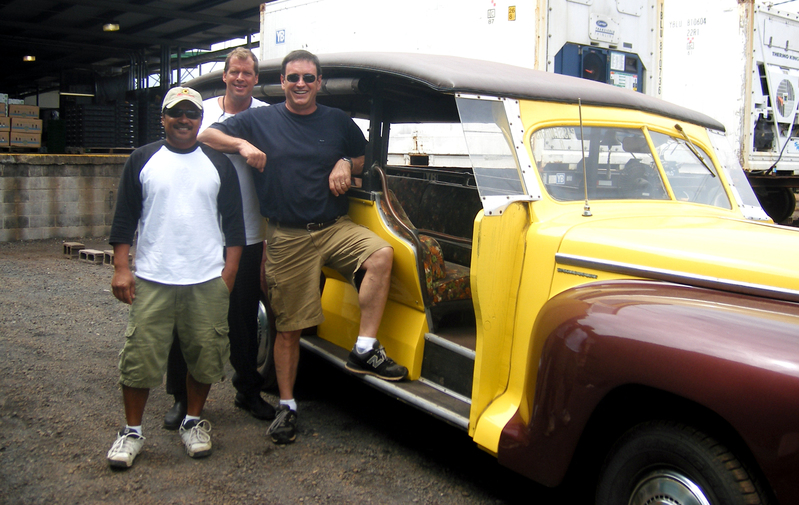Gordon “Da Sampan Man” Cline came to visit on Tuesday. He lives in Santa Barbara, California and owns one of the old Hilo sampan buses. I bought the sampan bus that was at the Lyman Museum at an auction several years ago.
He has managed to track down every one of the 12 sampan buses that are still in existence. He dropped off some news articles and we looked at pictures of the other buses.
Here’s a picture of our sampan and Chef Peter Merriman (right), as well as Assistant Chef Dan Salvador (left) and Chef Neil Murphy (middle).
This article was in the Honolulu Advertiser on June 21, 1959:
Hilo’s Sampan Buses
These special conveyances provide colorful transportation
By RON BENNETT
There’s nothing more distinctively Hilo than a Hilo Sampan bus.
They are an immediate delight for Visitors who’ve never seen anything quite like them before. You often see tourists congregating around a “captured” sampan. Snapping pictures for the folks back home.
For kicks the vacationers some times jump into one of the open air Jitneys and take a Hilo bus ride.
Hiloans regard their sampans bus system something in the possessive fashion that Bay City dwellers view their trolley cars.
A big hullabaloo was raised back in 1949 when exasperated Hawaii county officials tried to enforce some rhyme and reason in bus routes, pick ups and fares.
For decades the jitneys followed no set courses. They moseyed around town in a haphazard manner, picking up customers at random and taking them to entirely incompatible destinations.
Drivers complained of colleagues rustling their customers and invading vaguely defined boundaries of priority. Some were accused of cut throat tactics. And other types of unprofessional conduct.
In a nutshell, mass public transportation in Hilo was a mess.
However, some patrons—particularly those on better populated, thus better served streets—objected to any governmental changes that might adversely affect their good bus service. On rainy days they could depend on drovers taking them right up to the doorsteps, a service doomed under governmental controls.
Controls had to come and they did. Officials named a distinguished World War ll veteran, Tsuneo Takemoto, as director. With Italy behind him, he soon brought peace and regularity out of chaos.
Today 25 sampans serve 15 Hilo routes on a rotating basis so every driver can get a crack at the plushier routes. On these busier routes commuters have no longer than about 10 minutes to wait between buses.
A common belief that the unusual body used for the sampans comes from Manila or some other foreign place is incorrect. They are made in Hilo.
The same type of bus has been in operation in Hilo for at least 40 years, according to one oldtimer. One of the first to use the design is said to be the late Fukumatsu Kusumoto, who ran a jitney between the Hilo Wharf and uptown, ages ago.
One source believes Kusumoto took the body style from a picture he saw once of a bus in Mexico.
Recent years have brought about one noticeable change in the sampan buses. Once gawdy in their color schemes, they’re now more conservative in dress.


I wish they were back in service….!
Please lead the charge to bring them back to Hilo!!!!